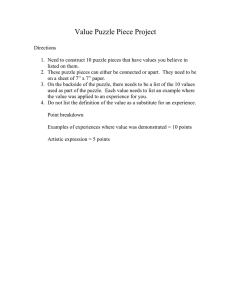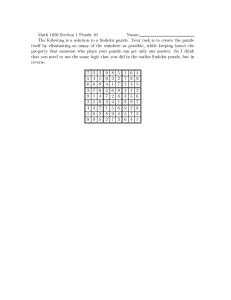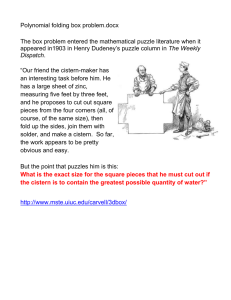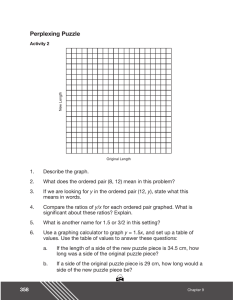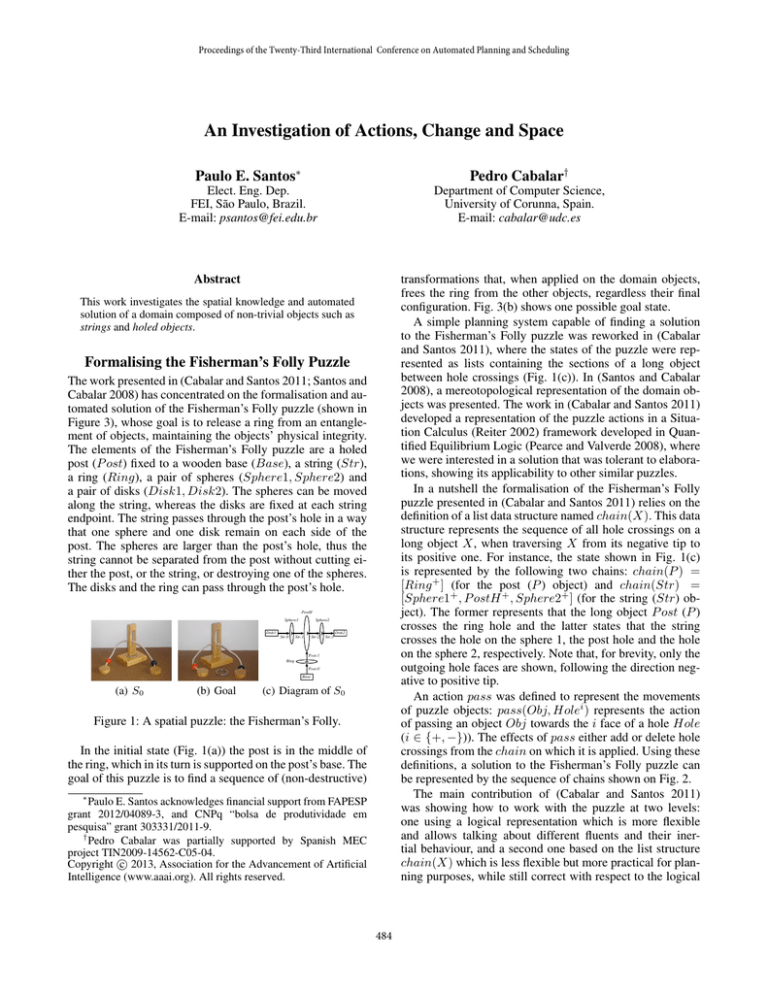
Proceedings of the Twenty-Third International Conference on Automated Planning and Scheduling
An Investigation of Actions, Change and Space
Paulo E. Santos∗
Pedro Cabalar†
Elect. Eng. Dep.
FEI, São Paulo, Brazil.
E-mail: psantos@fei.edu.br
Department of Computer Science,
University of Corunna, Spain.
E-mail: cabalar@udc.es
Abstract
transformations that, when applied on the domain objects,
frees the ring from the other objects, regardless their final
configuration. Fig. 3(b) shows one possible goal state.
A simple planning system capable of finding a solution
to the Fisherman’s Folly puzzle was reworked in (Cabalar
and Santos 2011), where the states of the puzzle were represented as lists containing the sections of a long object
between hole crossings (Fig. 1(c)). In (Santos and Cabalar
2008), a mereotopological representation of the domain objects was presented. The work in (Cabalar and Santos 2011)
developed a representation of the puzzle actions in a Situation Calculus (Reiter 2002) framework developed in Quantified Equilibrium Logic (Pearce and Valverde 2008), where
we were interested in a solution that was tolerant to elaborations, showing its applicability to other similar puzzles.
In a nutshell the formalisation of the Fisherman’s Folly
puzzle presented in (Cabalar and Santos 2011) relies on the
definition of a list data structure named chain(X). This data
structure represents the sequence of all hole crossings on a
long object X, when traversing X from its negative tip to
its positive one. For instance, the state shown in Fig. 1(c)
is represented by the following two chains: chain(P ) =
[Ring + ] (for the post (P ) object) and chain(Str) =
[Sphere1+ , P ostH + , Sphere2+ ] (for the string (Str) object). The former represents that the long object P ost (P )
crosses the ring hole and the latter states that the string
crosses the hole on the sphere 1, the post hole and the hole
on the sphere 2, respectively. Note that, for brevity, only the
outgoing hole faces are shown, following the direction negative to positive tip.
An action pass was defined to represent the movements
of puzzle objects: pass(Obj, Holei ) represents the action
of passing an object Obj towards the i face of a hole Hole
(i ∈ {+, −})). The effects of pass either add or delete hole
crossings from the chain on which it is applied. Using these
definitions, a solution to the Fisherman’s Folly puzzle can
be represented by the sequence of chains shown on Fig. 2.
The main contribution of (Cabalar and Santos 2011)
was showing how to work with the puzzle at two levels:
one using a logical representation which is more flexible
and allows talking about different fluents and their inertial behaviour, and a second one based on the list structure
chain(X) which is less flexible but more practical for planning purposes, while still correct with respect to the logical
This work investigates the spatial knowledge and automated
solution of a domain composed of non-trivial objects such as
strings and holed objects.
Formalising the Fisherman’s Folly Puzzle
The work presented in (Cabalar and Santos 2011; Santos and
Cabalar 2008) has concentrated on the formalisation and automated solution of the Fisherman’s Folly puzzle (shown in
Figure 3), whose goal is to release a ring from an entanglement of objects, maintaining the objects’ physical integrity.
The elements of the Fisherman’s Folly puzzle are a holed
post (P ost) fixed to a wooden base (Base), a string (Str),
a ring (Ring), a pair of spheres (Sphere1, Sphere2) and
a pair of disks (Disk1, Disk2). The spheres can be moved
along the string, whereas the disks are fixed at each string
endpoint. The string passes through the post’s hole in a way
that one sphere and one disk remain on each side of the
post. The spheres are larger than the post’s hole, thus the
string cannot be separated from the post without cutting either the post, or the string, or destroying one of the spheres.
The disks and the ring can pass through the post’s hole.
PostH
Sphere1
Sphere2
Disk1
Disk2
Str:0
Str:1
Str:2
Str:3
Post:1
Ring
Post:0
Base
(a) S0
(b) Goal
(c) Diagram of S0
Figure 1: A spatial puzzle: the Fisherman’s Folly.
In the initial state (Fig. 1(a)) the post is in the middle of
the ring, which in its turn is supported on the post’s base. The
goal of this puzzle is to find a sequence of (non-destructive)
∗
Paulo E. Santos acknowledges financial support from FAPESP
grant 2012/04089-3, and CNPq “bolsa de produtividade em
pesquisa” grant 303331/2011-9.
†
Pedro Cabalar was partially supported by Spanish MEC
project TIN2009-14562-C05-04.
c 2013, Association for the Advancement of Artificial
Copyright Intelligence (www.aaai.org). All rights reserved.
484
state
S0
s1
s2
chain(P )
[Ring + ]
[Ring + ]
[]
s3
[]
s4
[]
s5
[]
• Intentionality: The complexity issue mentioned above makes
us wonder why a human playing with such puzzles is not baffled
by the existence of infinite chains of actions and outcomes of
actions (and why most of (or some of) us do not get bored when
trying to solve it). There seems to be an intentionality behind the
actions people choose to apply on the domain. This intentionality is not only related to reducing the complexity of the entanglement, but also on a prediction of the possible states that the
action would lead to, and how they related to the solution. These
intentional heuristics are somewhat very elusive to define.
chain(Str)
[Sphere1+ , P ostH + , Sphere2+ ]
[Sphere1+ , P ostH + , Sphere2+ , P ostH − ]
[Sphere1+ , Ring − , P ostH + , Ring + ,
Ring − , Sphere2+ , Ring + , P ostH − ]
[Sphere1+ , Ring − , P ostH + , Sphere2+ ,
P ostH − , Ring + ]
[Sphere1+ , P ostH + , Ring − , Sphere2+ ,
Ring + , P ostH − ]
[Sphere1+ , P ostH + , Sphere2+ , P ostH − ]
• Learning domain constraints: In our previous work, the domain constraints were handwritten (i.e. we had to explicitly represent the cases where an object could not pass through a hole).
We believe that these constraints could be automatically learnt
within the reasoning procedures to solve the puzzle.
Figure 2: A formal solution for the Fisherman’s puzzle.
l(Str2,1)
S
Str1
R1
R3
• Real application domains: the importance of reasoning about
strings and holes goes beyond pure theoretical interest, embracing application domains such as: cabling, where reasoning about
flexible and perforated objects is needed for optimising the spatial arrangements of networks of cables; autonomous maintenance of mechanical machines, from which devices have to
be extracted without damaging the surrounding parts; robotic
surgery, where autonomous machines have to deal (and plan
how to handle) sutures in situations involving very distinct and
delicate structures.
Str2
OutL1
R2
l(Str2,0)
P
B
OutL2
(a) Puzzle
(b) Diagram
Figure 3: Easy does it.
• Obtaining specialist knowledge: related to the application domains cited in the previous item is the issue of how to obtain
specialist knowledge, and how this could interact with the planning task. This is particularly relevant in the (semi)autonomous
robotic surgery domain, where a human surgeon can interfere,
guide or prohibit certain actions as planned by the robotic agent.
representation. Still, from the planning perspective, the prototype planner considered in that paper consisted in a simple
blind search, iterative deepening strategy, capable of solving
the five steps of Fisherman’s Folly, but unable to deal in a
reasonable time with other similar problems with solutions
of a dozen steps.
• Proving physical feasibility: last but not least, how to guarantee
physical feasibility of the sequence of actions obtained by the
planner (without considering an entire 3D model of the domain
in the planning process) is a challenging open issue.
Solving puzzles with string loops
In none of our previous formalisations, however, the notion
of loop was taken into account. This is due to the fact that
the object “loop” was not relevant to the solution of the Fisherman’s Folly puzzle or its close relatives. The question that
naturally follows from this is whether these previous solutions are tolerant to this elaboration. Our current investigation aims to extend the framework presented in (Cabalar and
Santos 2011) towards the automated solution of puzzles that
involve reasoning about string loops, such as the Easy-doesit puzzle (Fig. 3(a)). In the Easy-does-it domain, loops in the
string form holes that are represented with two faces + and
-, as done previously for holes in rigid objects. Therefore, in
this case, actions on a string create a distinct kind object that
accept a distinct set of actions from those that can be applied
on the original string itself.
Conclusion
In this paper we discussed the challenging problem of formally describing flexible objects such as strings. We outlined an initial formalisation based on previous investigations on an automated solution for spatial puzzles. There is,
however, still a long way to go before deploying this initial
formalisation in a real application setting.
References
Cabalar, P., and Santos, P. E. 2011. Formalising the fisherman’s folly puzzle. Artif. Intell. 175(1):346–377.
Pearce, D., and Valverde, A. 2008. Quantified equilibrium
logic and foundations for answer set programs. In Proc. of
the 24th ICLP, volume 5366 of LNCS. Springer. 546–560.
Reiter, R. 2002. Knowledge in Action: Logical Foundations
for Specifying and Implementing Dynamical Systems. U.S.:
MIT Press.
Santos, P. E., and Cabalar, P. 2008. The space within fisherman’s folly: Playing with a puzzle in mereotopology. Spatial
Cognition & Computation 8(1-2):47–64.
Interesting issues in planning
The investigation of string puzzles, such as those considered
in this paper, brings up a number of issues of interest not
only to the knowledge representation field, but also to researchers in the planning community. Below we summarise
a few of the most important open issues in this respect.
• Complexity: how an efficient planner can deal with the large
amount of possible outcomes (infinite in fact) of applying a deformation action on a piece of string, let alone the possibility of
tying knots or tight entangling the string with the other objects.
485

